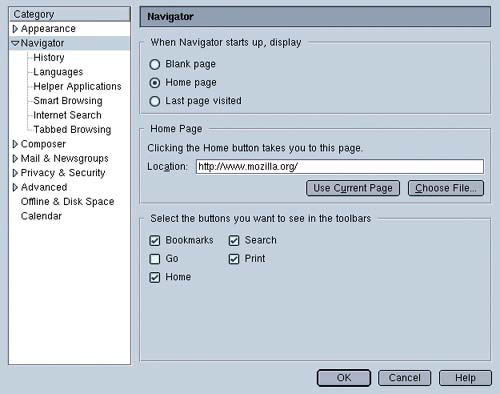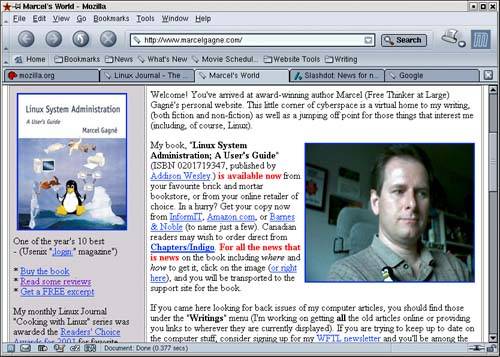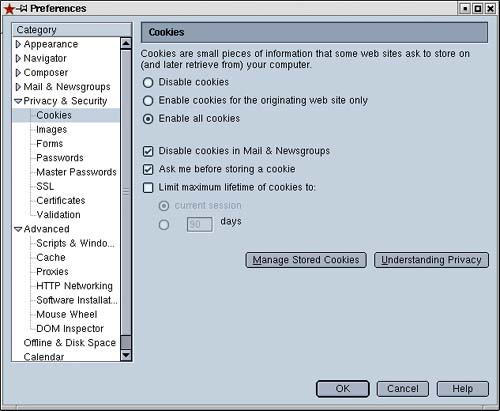Mozilla
To this day, I find myself switching back and forth between Mozilla (Figure 11-6) and Konqueror. The features I've mentioned for Konqueror make it an amazingly useful browser?in some ways, it is more like the Swiss Army knife of browsers. Mozilla, on the other hand, has the Netscape Navigator look and feel that I've grown accustomed to over the years in a much more mature and flexible package. It includes an email package and IRC client, is ideal for reading newsgroups, and comes with an HTML editor.
Figure 11-6. Mozilla, an excellent browser.

To start Mozilla, click on Kicker's big K, select Internet, and choose Mozilla from the list. If Mozilla isn't installed, you can get the package at http://www.mozilla.org or simply get it off your distribution CDs. If you do head to the Mozilla Web site, it probably makes sense to choose a stable release unless you are feeling particularly adventurous and want to experiment with the leading edge. Just remember that it can be wobbly on the edge.
Working from Home
When you first start Mozilla, it will take you to its home, the Mozilla welcome page. Getting to a Web site and navigating Mozilla is much the same as it is in any other browser you have used, particularly if you were using Netscape (or Mozilla) with your old OS. All you do is type the URL of the Web site you want to visit into the location bar, and away you go. If you would like to start each time on a personal home page, this is easily done.
Click on Edit in Mozilla's menu bar and select Preferences. The Preferences window opens up with a left-hand Category panel, from which you select what part of Mozilla you want to modify. By default, it opens up to the Navigator category?Navigator is the browser part of Mozilla (Figure 11-7). Over on the right side, there are three radio buttons. Clicking the top button will start Mozilla on a blank page, and clicking in the middle will let you specify a home page. The third radio button will tell Mozilla always to start up on the last page visited. Now looking below, you'll see a field for entering the URL of your desired home page?enter the URL there. When you are done, click OK.
Figure 11-7. Setting your home page in Mozilla's Preferences menu.

Mozilla Does Tabs, Too
Before I tell you how tabs work in Mozilla, it seems only fair that I should tell you that Mozilla had tabbed browsing before Konqueror did (particularly because I gave Konqueror first billing). The concept behind tabbed browsing in Mozilla is the same, but the keystrokes are a little different.
Start by visiting a site of your choice. Now click on File, select New, and choose Navigator Tab from the drop-down menu. You can also use the <Ctrl+T> keyboard shortcut to do the same thing. Notice that Mozilla now identifies your sites with tabs just below the location bar (Figure 11-8). Add a third or a fourth if you like. Switching from site to site is now just a matter of clicking the tabs on your single copy of Mozilla.
Figure 11-8. Mozilla showing off its tabs.

While in tab mode (as shown in Figure 11-8), you can right-click on a tab to bring up the tab menu. From there you can close or reload the current tab (or all tabs) and even open new tabs. Another way to close the active tab is to click on the X at the end of the tab list.
Still Don't Like Pop-Up Ads?
I have to mention this again because it is one of the things that make some of these Linux browsers so wonderful?the ability to stop unwanted pop-up window ads. Like Konqueror before, Mozilla lets you do this easily.
Start by bringing up the Preferences menu again (click Edit on the menu bar and choose Preferences). From the category list (Figure 11-9), choose Advanced and open the submenu (by clicking the little arrow directly to the left of the word Advanced). From that submenu, choose Scripts & Windows. The check box for Open unrequested windows is on. Check it off, then click OK to close the Preferences menu.
Figure 11-9. Configuring Mozilla to stop pop-up ads.

Controlling Cookies
Mozilla is also very versatile in its handling of cookies. Before you excitedly turn off all cookies, do remember that they can be useful, particularly with online services such as banks and e-commerce sites. That said, you may very much want to curb cookie traffic as much as possible.
From the Preferences menu, open up the Privacy & Security category submenu (Figure 11-10).
Figure 11-10. Back to Mozilla's Preferences menu to configure cookie policies.

Unless you really want to refuse all cookies, leave the Enable all cookies radio button checked on. Then make sure that you have radio button labeled Ask me before storing a cookie checked on. Click OK, and resume your surfing. When you visit a site that tries to set or modify a cookie, an alert will pop up, alerting you to the cookie and asking you how to proceed. If you decide to reject a cookie and you never want to see another cookie from that site, check Remember this decision before clicking No.
The Mozilla Sidebar
You have already seen the sidebar because it is open by default when you use Mozilla for the first time. The sidebar is a quick way to get to your information, be it bookmarks, active searches, and so on. You can quickly activate the sidebar by pressing <F9> or by clicking View on the menu bar, then selecting Show/Hide | Sidebar. The sidebar will appear (or disappear).
The sidebar makes Net searches easy. At the top of the sidebar, you'll see a search field. Just type your search keywords in the location bar and press <Enter>. By default, Mozilla will pass your search terms to Netscape's search engine. You can modify this default by going into the Preferences menu and choosing Internet Search under the Navigator category.
The sidebar is customizable, as well. While the sidebar is open, click on the Tabs drop-down list, select Customize Sidebar (Figure 11-11), and you can add, remove, or change the order of things as they appear.
Figure 11-11. Customizing the Mozilla sidebar.








